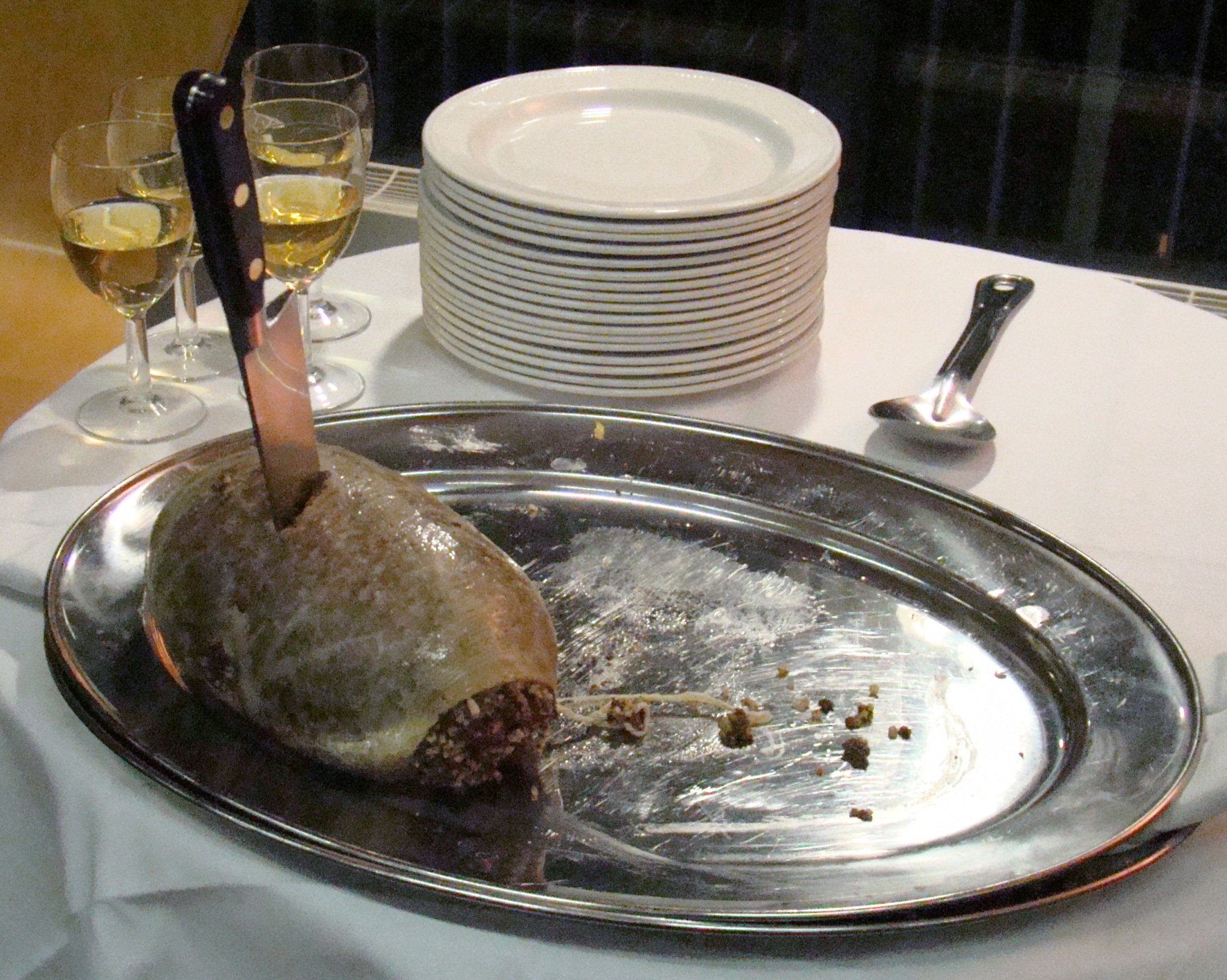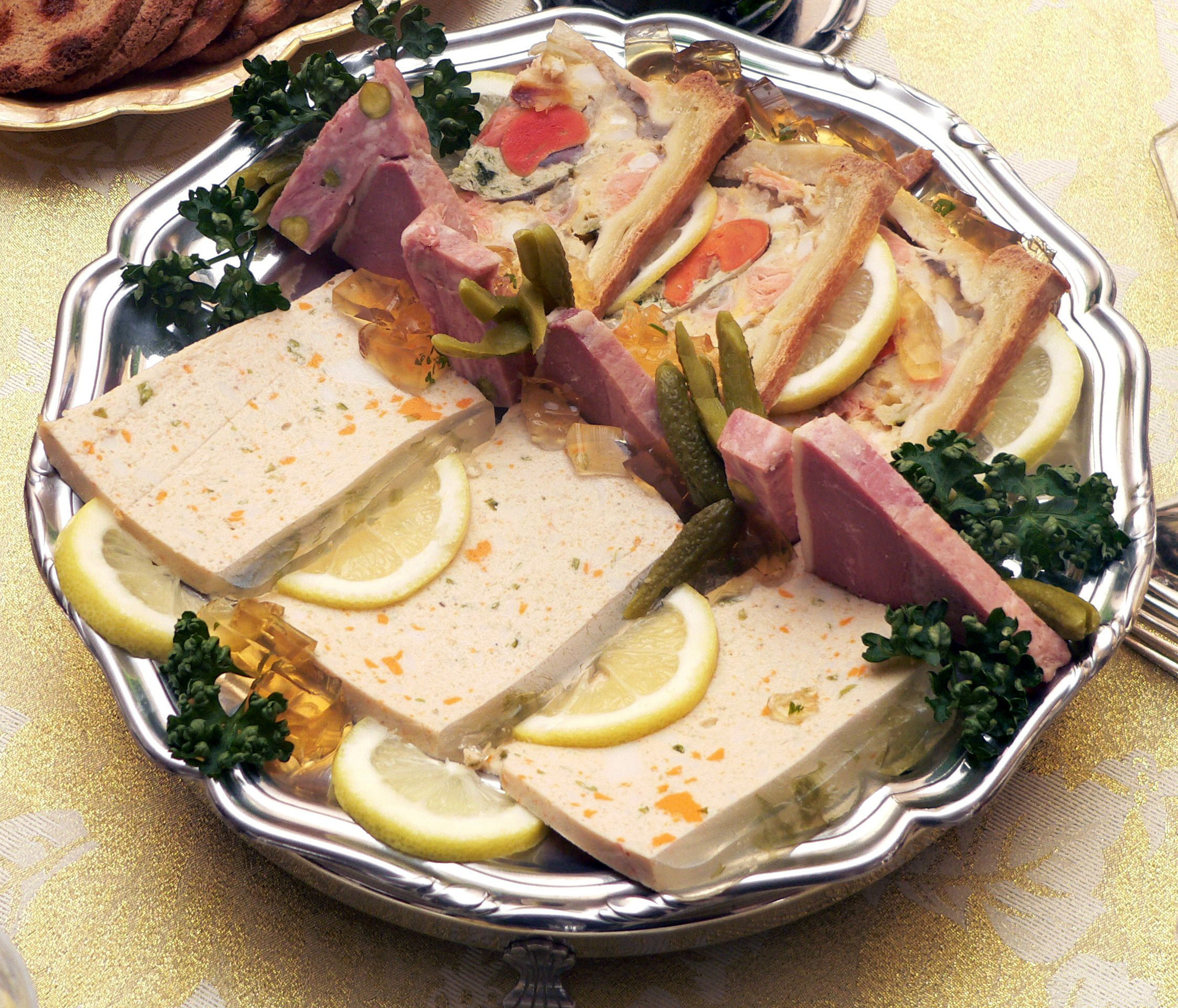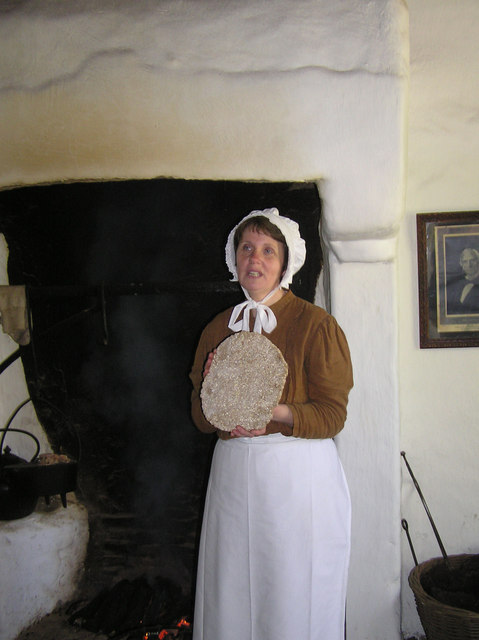|
Scottish Cuisine
Scottish cuisine encompasses the cooking styles, traditions and recipes associated with Scotland. It has distinctive attributes and recipes of its own, but also shares much with British and wider European cuisine as a result of local, regional, and continental influences—both ancient and modern. Scotland's natural larder of vegetables, fruit, oats, fish and other seafood, dairy products and game is the chief factor in traditional Scottish cooking, with a high reliance on simplicity, without the use of rare, and historically expensive, spices found abroad. History Scotland, with its temperate climate and abundance of indigenous game species, has provided food for its inhabitants for millennia. The wealth of seafood available on and off the coasts provided the earliest settlers with sustenance. Agriculture was introduced, and primitive oats quickly became the staple. Medieval From the journeyman down to the lowest cottar, meat was an expensive commodity, and would ... [...More Info...] [...Related Items...] OR: [Wikipedia] [Google] [Baidu] |
Haggis Neeps And Tatties
Haggis ( gd, taigeis) is a savoury pudding containing sheep's pluck (heart, liver, and lungs), minced with onion, oatmeal, suet, spices, and salt, mixed with stock, and cooked while traditionally encased in the animal's stomach though now an artificial casing is often used instead. According to the 2001 English edition of the ''Larousse Gastronomique'': "Although its description is not immediately appealing, haggis has an excellent nutty texture and delicious savoury flavour". It is believed that food similar to haggis—perishable offal quickly cooked inside an animal's stomach, all conveniently available after a hunt—was eaten from ancient times. Although the name "hagws" or "hagese" was first recorded in England c. 1430, the dish is considered traditionally of Scottish origin. It is even the national dish, as a result of Scots poet Robert Burns' poem "Address to a Haggis" of 1786. Haggis is traditionally served with "neeps and tatties", boiled and mashed separately, and ... [...More Info...] [...Related Items...] OR: [Wikipedia] [Google] [Baidu] |
Carbohydrate
In organic chemistry, a carbohydrate () is a biomolecule consisting of carbon (C), hydrogen (H) and oxygen (O) atoms, usually with a hydrogen–oxygen atom ratio of 2:1 (as in water) and thus with the empirical formula (where ''m'' may or may not be different from ''n''), which does not mean the H has covalent bonds with O (for example with , H has a covalent bond with C but not with O). However, not all carbohydrates conform to this precise stoichiometric definition (e.g., uronic acids, deoxy-sugars such as fucose), nor are all chemicals that do conform to this definition automatically classified as carbohydrates (e.g. formaldehyde and acetic acid). The term is most common in biochemistry, where it is a synonym of saccharide (), a group that includes sugars, starch, and cellulose. The saccharides are divided into four chemical groups: monosaccharides, disaccharides, oligosaccharides, and polysaccharides. Monosaccharides and disaccharides, the smallest (lower molecul ... [...More Info...] [...Related Items...] OR: [Wikipedia] [Google] [Baidu] |
Mary, Queen Of Scots
Mary, Queen of Scots (8 December 1542 – 8 February 1587), also known as Mary Stuart or Mary I of Scotland, was Queen of Scotland from 14 December 1542 until her forced abdication in 1567. The only surviving legitimate child of James V of Scotland, Mary was six days old when her father died and she inherited the throne. During her childhood, Scotland was governed by regents, first by the heir to the throne, James Hamilton, Earl of Arran, and then by her mother, Mary of Guise. In 1548, she was betrothed to Francis, the Dauphin of France, and was sent to be brought up in France, where she would be safe from invading English forces during the Rough Wooing. Mary married Francis in 1558, becoming queen consort of France from his accession in 1559 until his death in December 1560. Widowed, Mary returned to Scotland in August 1561. Following the Scottish Reformation, the tense religious and political climate that Mary encountered on her return to Scotland was further agitated ... [...More Info...] [...Related Items...] OR: [Wikipedia] [Google] [Baidu] |
Auld Alliance
The Auld Alliance (Scots for "Old Alliance"; ; ) is an alliance made in 1295 between the kingdoms of Scotland and France against England. The Scots word ''auld'', meaning ''old'', has become a partly affectionate term for the long-lasting association between the two countries. Although the alliance was never formally revoked, it is considered by some to have ended with the signing of the Treaty of Edinburgh in 1560. The alliance played a significant role in the relations among Scotland, France and England. The alliance was renewed by all the French and Scottish monarchs of that period except Louis XI. By the late 14th century, the renewal occurred regardless of whether either kingdom was at war with England at the time.BONNER, ELIZABETH. “Scotland’s ‘Auld Alliance’ with France, 1295–1560.” ''History'', vol. 84, no. 273, Wiley, 1999, pp. 5–30, . The alliance began with the treaty signed by John Balliol and Philip IV of France in 1295 against Edward I of Eng ... [...More Info...] [...Related Items...] OR: [Wikipedia] [Google] [Baidu] |
French Cuisine
French cuisine () is the cooking traditions and practices from France. It has been influenced over the centuries by the many surrounding cultures of Spain, Italy, Switzerland, Germany and Belgium, in addition to the food traditions of the regions and colonies of France. In the 14th century, Guillaume Tirel, a court chef known as "Taillevent", wrote '' Le Viandier'', one of the earliest recipe collections of medieval France. In the 17th century, chefs François Pierre La Varenne and Marie-Antoine Carême spearheaded movements that shifted French cooking away from its foreign influences and developed France's own indigenous style. Cheese and wine are a major part of the cuisine. They play different roles regionally and nationally, with many variations and ''appellation d'origine contrôlée'' (AOC) (regulated appellation) laws. Culinary tourism and the '' Guide Michelin'' helped to acquaint commoners with the ''cuisine bourgeoise'' of the urban elites and the peasant ... [...More Info...] [...Related Items...] OR: [Wikipedia] [Google] [Baidu] |
Scotland In The Early Modern Period
Scotland in the early modern period refers, for the purposes of this article, to Scotland between the death of James IV in 1513 and the end of the Jacobite risings in the mid-eighteenth century. It roughly corresponds to the early modern period in Europe, beginning with the Renaissance and Reformation and ending with the start of the Enlightenment and Industrial Revolution. After a long minority, the personal reign of James V saw the court become a centre of Renaissance patronage, but it ended in military defeat and another long minority for the infant Mary Queen of Scots. Scotland hovered between dominance by the English and French, which ended in the Treaty of Edinburgh 1560, by which both withdrew their troops, but leaving the way open for religious reform. The Scottish Reformation was strongly influenced by Calvinism leading to widespread iconoclasm and the introduction of a Presbyterian system of organisation and discipline that would have a major impact on Scottish life ... [...More Info...] [...Related Items...] OR: [Wikipedia] [Google] [Baidu] |
Scandinavia
Scandinavia; Sámi languages: /. ( ) is a subregion in Northern Europe, with strong historical, cultural, and linguistic ties between its constituent peoples. In English usage, ''Scandinavia'' most commonly refers to Denmark, Norway, and Sweden. It can sometimes also refer more narrowly to the Scandinavian Peninsula (which excludes Denmark but includes part of Finland), or more broadly to include all of Finland, Iceland, and the Faroe Islands. The geography of the region is varied, from the Norwegian fjords in the west and Scandinavian mountains covering parts of Norway and Sweden, to the low and flat areas of Denmark in the south, as well as archipelagos and lakes in the east. Most of the population in the region live in the more temperate southern regions, with the northern parts having long, cold, winters. The region became notable during the Viking Age, when Scandinavian peoples participated in large scale raiding, conquest, colonization and trading mostly throughout Eu ... [...More Info...] [...Related Items...] OR: [Wikipedia] [Google] [Baidu] |
Norsemen
The Norsemen (or Norse people) were a North Germanic ethnolinguistic group of the Early Middle Ages, during which they spoke the Old Norse language. The language belongs to the North Germanic branch of the Indo-European languages and is the predecessor of the modern Germanic languages of Scandinavia. During the late eighth century, Scandinavians embarked on a large-scale expansion in all directions, giving rise to the Viking Age. In English-language scholarship since the 19th century, Norse seafaring traders, settlers and warriors have commonly been referred to as Vikings. Historians of Anglo-Saxon England distinguish between Norse Vikings (Norsemen) from Norway who mainly invaded and occupied the islands north and north-west of Britain, Ireland and western Britain, and Danish Vikings, who principally invaded and occupied eastern Britain. Modern descendants of Norsemen are the Danes, Icelanders, Faroe Islanders, Norwegians, and Swedes, who are now generally referred to ... [...More Info...] [...Related Items...] OR: [Wikipedia] [Google] [Baidu] |
Offal
Offal (), also called variety meats, pluck or organ meats, is the organs of a butchered animal. The word does not refer to a particular list of edible organs, which varies by culture and region, but usually excludes muscle. Offal may also refer to the by-products of milled grains, such as corn or wheat. Some cultures strongly consider offal as food to be taboo, while others use it as everyday food or even as delicacies. Certain offal dishes—including '' foie gras'', '' pâté'', and haggis —are internationally regarded as gourmet food in the culinary arts. Others remain part of traditional regional cuisine and may be consumed especially during holidays. This includes sweetbread, Jewish chopped liver, U.S. chitterlings, Mexican menudo, as well as many other dishes. On the other hand, intestines are traditionally used as casing for sausages. Depending on the context, ''offal'' may refer only to those parts of an animal carcass discarded after butchering or s ... [...More Info...] [...Related Items...] OR: [Wikipedia] [Google] [Baidu] |
Haggis
Haggis ( gd, taigeis) is a savoury pudding containing sheep's pluck (heart, liver, and lungs), minced with onion, oatmeal, suet, spices, and salt, mixed with stock, and cooked while traditionally encased in the animal's stomach though now an artificial casing is often used instead. According to the 2001 English edition of the '' Larousse Gastronomique'': "Although its description is not immediately appealing, haggis has an excellent nutty texture and delicious savoury flavour". It is believed that food similar to haggis—perishable offal quickly cooked inside an animal's stomach, all conveniently available after a hunt—was eaten from ancient times. Although the name "hagws" or "hagese" was first recorded in England c. 1430, the dish is considered traditionally of Scottish origin. It is even the national dish, as a result of Scots poet Robert Burns' poem "Address to a Haggis" of 1786. Haggis is traditionally served with "neeps and tatties", boiled and mashed separately ... [...More Info...] [...Related Items...] OR: [Wikipedia] [Google] [Baidu] |
Griddle
A griddle, in the UK also called a girdle, is a cooking device consisting mainly of a broad, usually flat cooking surface. Nowadays it can be either a movable metal pan- or plate-like utensil, a flat heated cooking surface built into a stove or kitchen range, or a compact cooking machine with its own heating system attached to an integrated griddle acting as a cooktop. A traditional griddle can either be a brick slab or tablet, or a flat or curved metal disc, while in industrialized countries a griddle is most commonly a flat metal plate. A griddle can have both residential and commercial applications, and can be heated directly or indirectly. The heating can be supplied either by a flame fuelled by wood, coal, or gas; or by electrical elements. Commercial griddles run on electricity, natural gas or propane. [...More Info...] [...Related Items...] OR: [Wikipedia] [Google] [Baidu] |
Oatcakes
An oatcake is a type of flatbread similar to a cracker or biscuit, or in some versions takes the form of a pancake. They are prepared with oatmeal as the primary ingredient, and sometimes include plain or wholemeal flour as well. Oatcakes are cooked on a griddle (''girdle'' in Scots) or baked in an oven. History Oatcakes have been documented as existing in Scotland since at least the time of the Roman conquest of Britain in AD 43, and likely before then. Oatcakes have also been described as being the "mainstay of Scottish breads for centuries". Jean Le Bel, around AD 1357-60 describes the Beguine nuns making "little pancakes rather like communion wafers". This is thought to be an early description of a Scottish oatcake. Regional variations Oatcake variations exist based upon the different preparations in various countries and regions. Great Britain Seen as a typically Scottish food item, oatcakes have also long been made elsewhere in Britain. Oatcakes may replace toast at ... [...More Info...] [...Related Items...] OR: [Wikipedia] [Google] [Baidu] |





.jpg)





